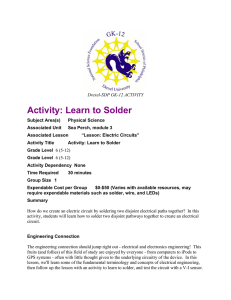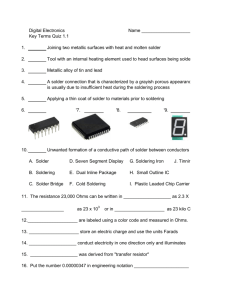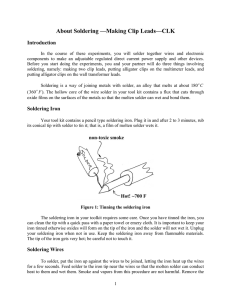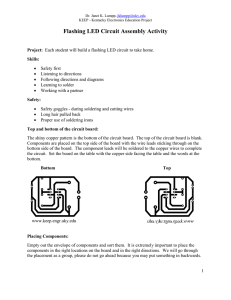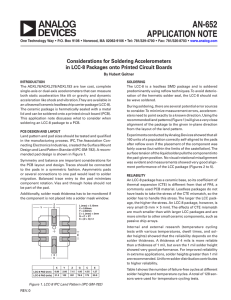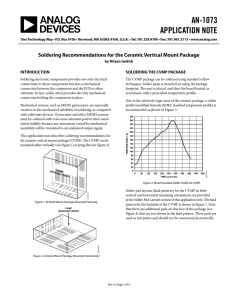Activity: Learn to Solder
advertisement
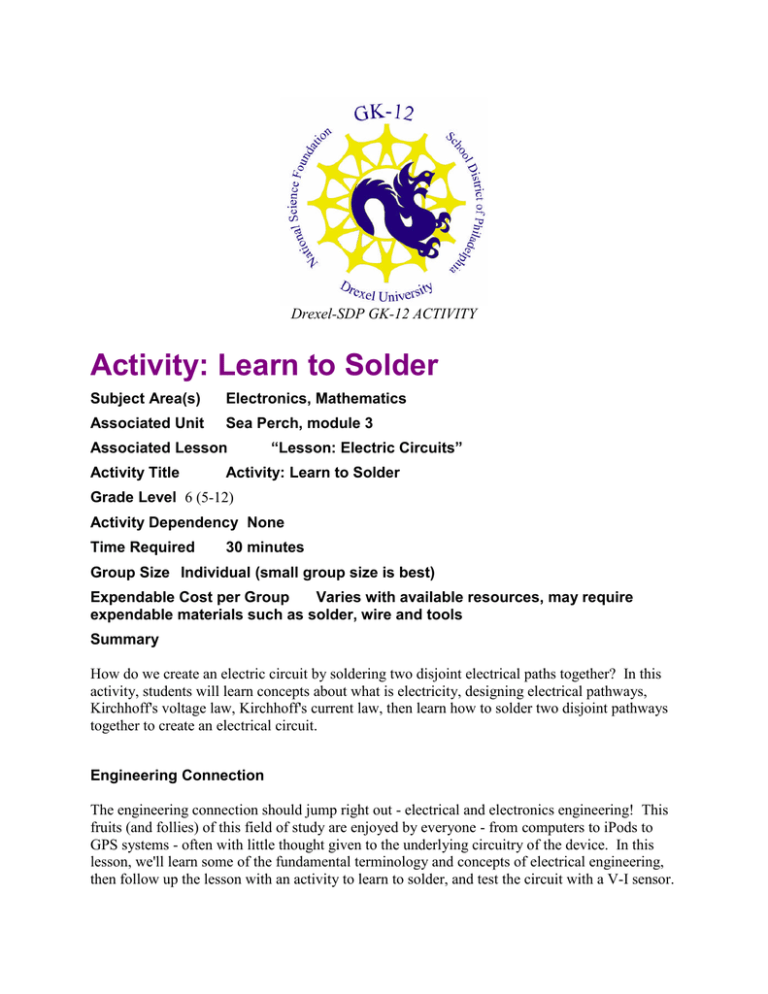
Drexel-SDP GK-12 ACTIVITY Activity: Learn to Solder Subject Area(s) Electronics, Mathematics Associated Unit Sea Perch, module 3 Associated Lesson Activity Title “Lesson: Electric Circuits” Activity: Learn to Solder Grade Level 6 (5-12) Activity Dependency None Time Required 30 minutes Group Size Individual (small group size is best) Expendable Cost per Group Varies with available resources, may require expendable materials such as solder, wire and tools Summary How do we create an electric circuit by soldering two disjoint electrical paths together? In this activity, students will learn concepts about what is electricity, designing electrical pathways, Kirchhoff's voltage law, Kirchhoff's current law, then learn how to solder two disjoint pathways together to create an electrical circuit. Engineering Connection The engineering connection should jump right out - electrical and electronics engineering! This fruits (and follies) of this field of study are enjoyed by everyone - from computers to iPods to GPS systems - often with little thought given to the underlying circuitry of the device. In this lesson, we'll learn some of the fundamental terminology and concepts of electrical engineering, then follow up the lesson with an activity to learn to solder, and test the circuit with a V-I sensor. Keywords Electric circuits, circuits, electrical engineering, electronics, current, voltage Educational Standards Science: Physical Science, Chemistry and Physics - Energy 3.4.B, Technology Education Physical Technologies 3.6.C. Math: Computation and Estimation 2.2 Pre-Requisite Knowledge Some knowledge of electrical circuit terminology Learning Objectives After this lesson, students should be able to: Be able to give a 5 minute talk on a topic Be able to prepare visual aids for a presentation Materials List Each group needs: Soldering iron Solder wire pieces wire stripper breadboard 5v battery LEDs. Introduction / Motivation Engineers and scientists are often asked to give a presentation as part of their work. The audience may vary from being colleagues (who are generally conversant in the subject of the presentation) to the general public (who are generally unfamiliar with the topic at hand). The point of a good presentation is to educate and inform the audience of new developments and challenges of a particular topic, regardless of their level of familiarity. It is a commonly accepted fact that people like to be told things, rather than reading them. Moreover, listeners don't merely want to be informed, they want to be entertained and stimulated as well. That's why presenters are repeatedly reminded not to read off their notes – it makes them seem unprepared and uninteresting. This lesson gives the general format and tips for a successful presentation. In addition, there are few better ways of taking command of information than by preparing a presentation on the subject. In this lesson, it is emphasized that one of the best ways to gain 2 mastery of a new or unfamiliar subject is to teach it to an audience. This activity asks students to practice the presentation skills addressed in the accompanying lesson. Vocabulary / Definitions Word Electricity Electric current Electric power Electric potential Solder (v.) Solder (n.) Resistor Voltage source Definition Energy that is transmitted in the form of rays A flow of electrons The amount of work done by an electric current Measurement of the distance from the equator Fasten together pieces of metal The metal compound used to fasten together two pieces of metal A device used to oppose the flow of electric current. Device that supplies electric potential Procedure Background This lesson is intended to help students understand electrical energy. It is not necessary to memorize all the terminology, but the students should be aware of some different examples of electrical energy. Also, the students should be exposed to an electrical circuit diagram and be able to identify the voltage source and resistors on the diagram. Before the Activity This activity will be conducted after some discussion what is electricity, the symbols and relationships by which we describe electrical phenomena, the fundamental Kirchhoff laws of electrical phenomena, and designing electrical circuits. With the Students Step 1: Put on safety goggles. Step 2: Examine the LED on the breadboard containing two disjoint, open electrical circuits. Does the LED light up when the battery is connected? Step 3: Strip about " insulation off both ends of two short wires. Step 4: Following the technique shown by the instructors, tin the contacts (the exposed wire) of one end on each of the wires using the pre-heated soldering iron and a bit of flux solder. Step 5: Following the technique shown by the instructors, solder the tinned ends of the wire together using the pre-heated soldering iron and a little bit more solder. Step 6: After the soldered wires have cooled, insert the non-soldered ends of the joined wire into the breadboard as shown by the instructors. 3 Step 7: Connect the 12v battery to the positive and negative terminals of the breadboard as shown by the instructors. Does the LED light up? Safety Issues Make sure students wear safety goggles Be sure the students do not hover over soldering to avoid breathing fumes Provide ample space between students soldering Be aware of the location of cords, soldering irons and flammable materials Troubleshooting Tips If the electrical connection is not made between materials, use a V-I meter to identify the open part of the circuit. If the solder is not melting, give the iron more time to heat or dial up the wattage of the iron (if available). If you cannot solder to a surface, be sure all protective coatings have been removed or sanded. Investigating Questions Question 1: Why did the LED not light up before you had inserted the soldered wire? Can you draw a picture of the electrical design? Question 2: Why did the LED light up before you had inserted a correctly-soldered wire? Can you draw a picture of the electrical design? Question 3: What would happen to the LED if we used an AA battery for the power supply? A wall outlet? (hint: don't try it) Assessment Pre-Activity Assessment None Activity Embedded Assessment Supervise the students to ensure proper safety procedures. Post-Activity Assessment - Notebook completeness (vocabulary, experimental data, other notes as necessary) - Ask to see the students' notebooks to ensure they have recorded the lesson notes - design a short quiz of 5-6 questions to see if the students were listening. In addition, you may use the rubric below. Activity Extensions Construct the SeaPerch underwater remote controlled vessel – see http://www.coe.drexel.edu/seaperch/ Owner Drexel University GK-12 Program Contributors: Dara Kusic Copyright: Copyright 2007 Drexel University GK12 Program. Reproduction permission is granted for non-profit educational use Version: Mar 2007 4
